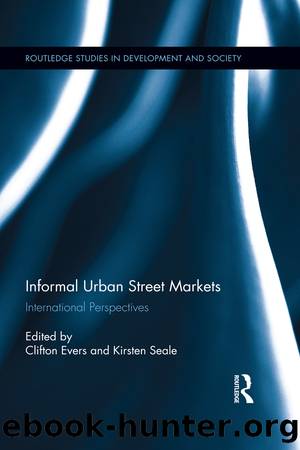Informal Urban Street Markets by Clifton Evers Kirsten Seale

Author:Clifton Evers, Kirsten Seale [Clifton Evers, Kirsten Seale]
Language: eng
Format: epub
ISBN: 9781138546394
Barnesnoble:
Publisher: Taylor & Francis
Published: 2018-02-12T00:00:00+00:00
What emerge are relationships between and negotiations of âstriated spaceâ and âsmooth spaceâ (Deleuze & Guattari, 1987). Striated space is ordered, systematic, restricted, and closed. Smooth space is heterogeneous and transgressive, a multiplicity of diverse connections, encounters, and becomings. These are not opposed models but rather âthe two spaces in fact coexist only in mixture: smooth space is constantly being translated, traversed into striated space; striated space is constantly being reversed, returned to smooth spaceâ (p. 23). It is a process âperpetually in construction or collapsingâ (p. 22).
Police and chengguan (âurban management officersâ) did the enforcing of striated space.5 Chengguan have no legal authority, but are used by the government to augment police in enforcing municipal laws, regulations, and codes. The crackdowns were particularly worrisome for vendors without a Shanghai hukou cardâa place- specific urban residency card connected to a registration system. Some of the street vendors who were becoming- tricycle at the Pengpu night market were migrant workers (mingong). They arrive from rural or regional areas outside Shanghai. Migrants move to Shanghai from provinces such as Anhui, Jiangsu, Henan, and Sichuan. Urbanization has involved a large population movement (liudong renkou) to the major cities (Meng et al., 2010). Nationally, in 2011 there were at least 262.1 million migrant workers (Shanghai Municipal Information Office, 2012). The flow of people became regulated because of the pressures it brought to bear on city space and resources, as well as government services, planning, and finances. The regulation (blockage) to the flow of people occurs via the resident registration system (hukou) (Cai, 2000; Meng et al., 2010). Without a place- specific urban residency card the migrants have only limited access to various social services, such as schools, health care, work, and pension insurance (Meng et al., 2010).6 As Dianne Currier (2003) points out, assemblages occur in relation to âregimes of signs and relations of power,â which aim to and can âachieve a meta- stabilityâ (p. 327).
People move to Shanghai to find employment, although some of the younger people also seek adventure and to escape the âboredomâ of village life, as one young vendor told me. The migrants use kin (xueyuan) and place-ties (diyuan) to raise money and purchase their tricycle and goods to sell, or to make adaptations to their tricycles in order to offer services. Some get their start- up capital by borrowing from the pooled savings (jÄ«xù) of their working group (dÄnwèi). Informal banking is common in China (Tsai, 2002). Becoming- tricycle and the concomitant street vending have low barriers to entry in terms of cost and education, which makes it possible for people to generate livelihoods for themselves. Some people choose vending owing to its flexible work hours and for social and cultural reasons, such as gender, interaction, physicality, and tradition. Becoming- tricycle provides opportunities for livelihoods over which people may have more control; for example, it provides working conditions that are flexible for those with a high degree of familial duties. Also, becoming- tricycle is a way of avoiding the somewhat Kafkaesque red tape and bureaucracy of the Chinese government.
Download
This site does not store any files on its server. We only index and link to content provided by other sites. Please contact the content providers to delete copyright contents if any and email us, we'll remove relevant links or contents immediately.
Chaco's Northern Prodigies : Salmon, Aztec, and the Ascendancy of the Middle San Juan Region after AD 1100 by Paul F. Reed(347)
Law Enforcement Interpersonal Communication and Conflict Management by Brian Douglas Fitch(344)
Digital International Relations by Unknown(338)
Critical Perspectives on Human Security : Rethinking Emancipation and Power in International Relations by David Chandler; Nik Hynek(322)
Skilled interpersonal communication: Research, theory and practice, Fifth edition by Owen Hargie(320)
The Enduring Color Line in U.S. Athletics by Krystal Beamon Chris M. Messer(317)
Evidence-Based Policy Making in Labor Economics by Hamermesh Daniel S.;Nottmeyer Olga K.;Nottmeyer Olga;King Sarah;King Sarah;King Sarah;(291)
EPSO CAST Political affairs EU policies: How to succeed in the selection procedure by Franco Reverte José María(281)
Criminological Theory in Context by John Martyn Chamberlain(264)
Writing Public Policy - A Practical Guide to Communicating in the Policy Making Process by Catherine F. Smith(263)
Threshold Concepts in Women's and Gender Studies by Christie Launius Holly Hassel(259)
Tibeton Yoga Its Secret Doc by Evans-Wentz(257)
Social Problems, Social Issues, Social Science by James Wright(254)
Positive Psychology and Spirituality in Counselling and Psychotherapy (Conflict, Ethics, and Spirituality, 12) by unknow(254)
Rothschild and Early Jewish Colonization in Palestine (Geographical Perspectives on the Human Past) by Ran Aaronsohn(254)
Play in child development and psychotherapy: toward empirically supported practice by Sandra W. Russ(248)
Cognitive Development in Infancy and Childhood (Elements in Child Development) by Mary Gauvain(245)
Latin American Politics and Society by Gerardo L. Munck & Juan Pablo Luna(217)
What Makes a Social Crisis?: The Societalization of Social Problems by Jeffrey C. Alexander(215)
